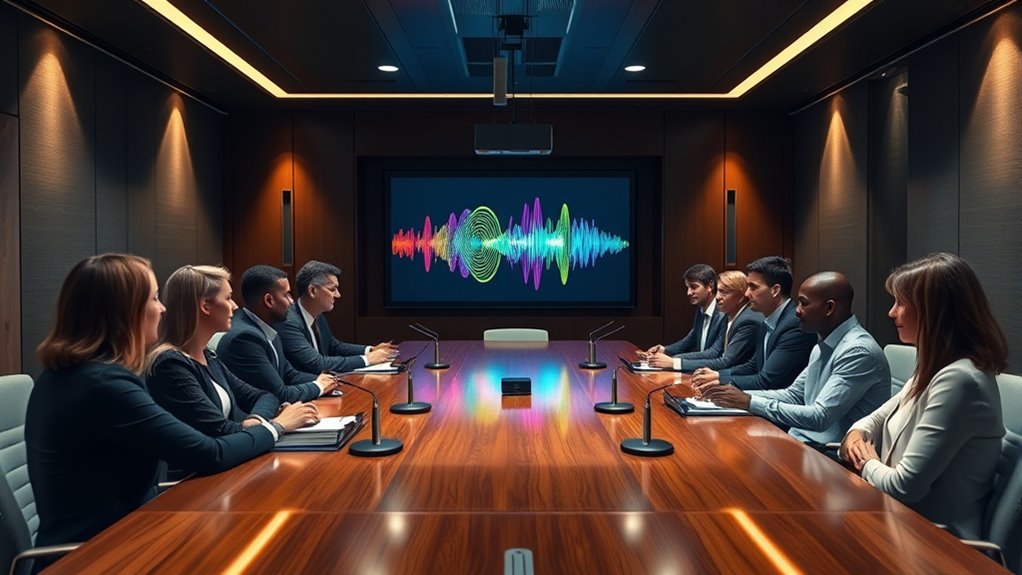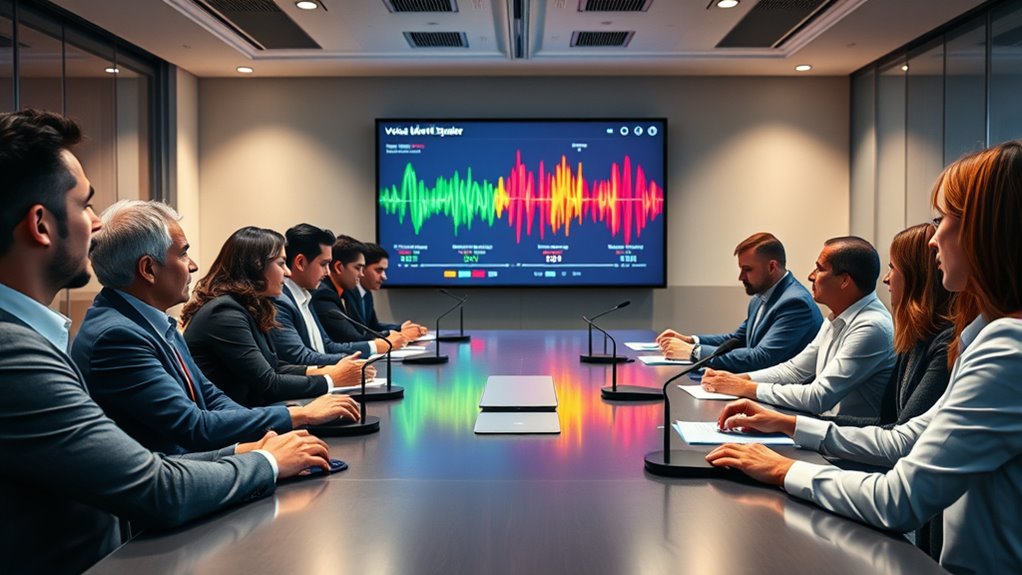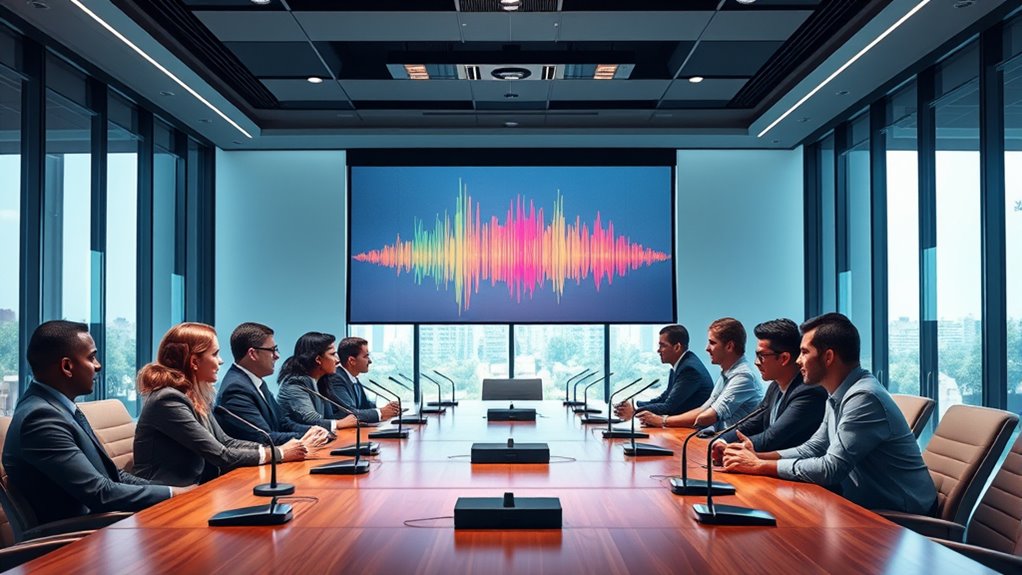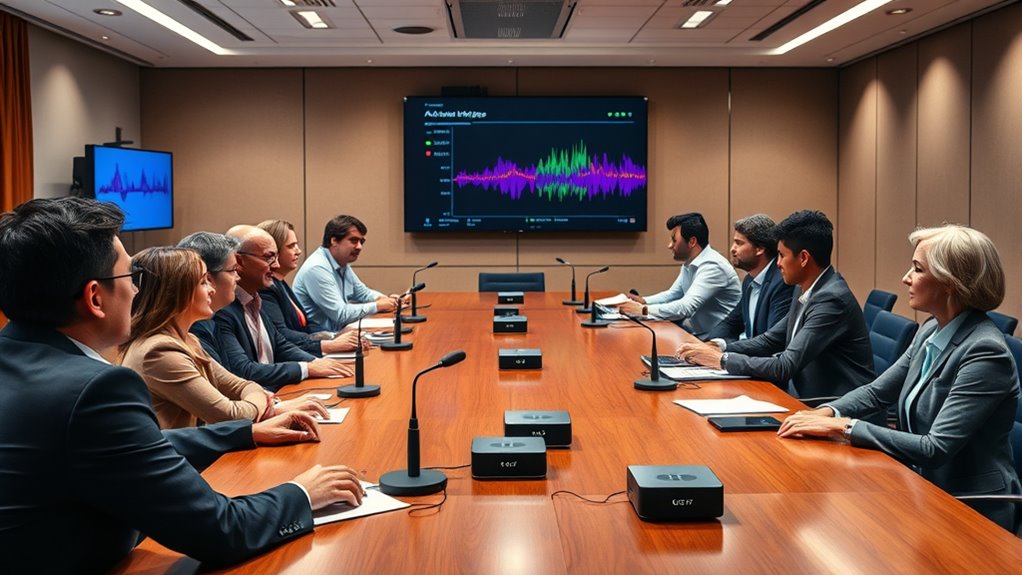Automatic speaker identification helps you make sense of group meetings by accurately recognizing each participant’s voice, even in noisy or dynamic environments. It analyzes unique vocal features to distinguish speakers and assigns speech segments properly, improving note-taking, transcription, and accountability. This technology boosts clarity and security while reducing errors. If you want to explore how ASI can transform your meetings and address potential challenges, there’s more to discover as you continue.
Key Takeaways
- ASI accurately assigns speech segments to individual speakers, improving clarity and attribution in group meetings.
- It enhances transcription quality by automatically labeling speakers, making meeting summaries more understandable.
- Real-time speaker recognition facilitates security, accountability, and seamless communication during dynamic discussions.
- Combining audio with visual data boosts identification accuracy, even in noisy or complex environments.
- Addressing privacy concerns ensures secure handling of voice data while maintaining user trust and legal compliance.
The Basics of Automatic Speaker Identification

Automatic speaker identification is a technology that determines who is speaking based solely on their voice. It analyzes unique vocal features to distinguish individuals, even in challenging environments. Background noise can interfere with accuracy, but advanced algorithms filter out irrelevant sounds, focusing on voice signals. Voice modulation, such as pitch and tone changes, is also accounted for, ensuring reliable identification despite speech variations. The system captures speech patterns and compares them to known voice profiles stored in a database. This process happens quickly, enabling real-time recognition. With these capabilities, automatic speaker identification becomes a powerful tool for security, transcription, and communication, helping systems understand who is talking without requiring manual input. It’s a foundational component in automating voice-related tasks and improving overall accuracy. Additionally, understanding the role of audio quality is crucial, as clear and high-quality recordings significantly enhance the system’s effectiveness.
How ASI Works in Group Settings

When multiple people are speaking, ASI systems use advanced audio signal processing to separate individual voices. They then extract unique voice features to distinguish each speaker, even in noisy environments. Finally, clustering techniques group similar voice patterns to identify who is speaking in real-time. Incorporating voice recognition technology, ASI systems can further improve accuracy by matching voices to known speakers for more precise identification.
Audio Signal Processing
In group settings, audio signal processing for speaker identification involves isolating each person’s voice from a mixture of overlapping sounds. You start by filtering out background noise, which enhances the clarity of each speaker’s voice. Noise filtering reduces unwanted sounds like chatter, typing, or room echoes, making it easier to differentiate voices. Additionally, you must account for voice modulation, as speakers often change pitch, tone, or volume. This variability can complicate identification, so advanced algorithms adjust for these changes in real-time. By cleaning the audio with noise filtering and compensating for voice modulation, the system creates a clearer, more distinct audio profile for each speaker. This process sets the foundation for accurate speaker recognition in dynamic, real-world environments. Trustworthy technology ensures that these systems maintain high accuracy and reliability in various settings.
Voice Feature Extraction
Once background noise has been filtered out and voice modulation is accounted for, the next step in speaker identification is extracting distinguishing voice features. You focus on capturing unique vocal biomarkers that set each person apart. These features include pitch, tone, and speech rhythm, which reveal individual vocal patterns. Voice feature extraction also considers speech emotion, adding depth to personality cues and emotional states. Incorporating advanced technology enables more precise analysis of these vocal characteristics, improving the overall accuracy of the identification process.
Speaker Clustering Techniques
Speaker clustering techniques enable automatic speaker identification systems to distinguish and group multiple speakers within an audio stream. These methods rely on voice diarization, which segments the audio into speaker-specific segments through speaker segmentation. Once the speech is segmented, clustering algorithms analyze voice features to group segments from the same speaker, even if they speak at different times. Techniques like k-means, agglomerative clustering, and spectral clustering help organize the data efficiently. By accurately identifying which segments belong to which speaker, these techniques facilitate clearer understanding in group settings, such as meetings or conferences. Effective speaker clustering reduces confusion, improves transcription accuracy, and supports real-time applications, making group interactions more manageable and insightful. Additionally, Honda Tuning modifications such as ECU remapping and suspension upgrades can enhance the overall clarity and performance of audio systems within vehicles, further supporting better speaker identification in automotive environments.
Technologies Behind Speaker Recognition

Have you ever wondered how a system can accurately identify who’s speaking just from their voice? The core technologies involve voice biometrics and acoustic modeling. Voice biometrics analyzes unique vocal features, like pitch and tone, to distinguish speakers. Acoustic modeling creates mathematical representations of these features, enabling the system to compare voice samples effectively. Key aspects include:
- Extracting distinctive vocal traits for identification
- Building detailed voice profiles through acoustic models
- Matching real-time speech against stored voiceprints
- Ensuring AI security measures are in place to prevent spoofing and manipulation
These technologies work together to ensure high accuracy in speaker recognition. By focusing on the vocal characteristics that make each person unique, systems can reliably identify speakers in real-world scenarios, such as meetings or conference calls. This technological foundation is essential for automatic speaker identification systems to function effectively.
Benefits of Implementing ASI in Meetings

Ever wondered how automatic speaker identification can enhance meetings? By enabling precise speaker diarization, ASI guarantees each person’s contributions are correctly attributed, making conversations clearer and more organized. This technology helps you easily distinguish who said what, even in large, dynamic group discussions. Acoustic modeling plays a crucial role, improving the system’s ability to recognize different voices amidst background noise or overlapping speech. Implementing ASI streamlines note-taking, reduces misunderstandings, and boosts meeting productivity. It also facilitates accurate transcription and record-keeping, saving you time and effort in post-meeting analysis. Understanding the security aspects of the technology ensures data privacy and compliance are maintained. Overall, integrating ASI into meetings helps create a more efficient, transparent, and accessible communication environment, ensuring everyone’s voice is heard and correctly identified.
Challenges and Limitations of ASI

While automatic speaker identification offers many advantages, it also faces significant challenges that can limit its effectiveness. Privacy concerns are a major issue, as sensitive data must be collected and stored securely. Data security risks include potential breaches that expose personal information. Additionally, ASI systems struggle with:
- Variability in audio quality and background noise
- Similar voice characteristics among different speakers
- Accurately identifying speakers in large, dynamic groups
These factors can cause errors and reduce reliability. Privacy concerns and data security are vital, as mishandling voice data could violate regulations or erode trust. To enhance system robustness, ongoing system improvements are necessary to address these issues. Overcoming these challenges requires robust encryption, clear privacy policies, and continuous system improvements to guarantee both accuracy and protection.
Practical Applications of Speaker Identification

Are you curious about how automatic speaker identification is transforming real-world scenarios? This technology enhances security, such as in access control and surveillance, allowing quick identification of individuals. It also improves meeting productivity by accurately attributing speech, making discussions clearer and more organized. Businesses use ASI for customer service, verifying identities efficiently. However, cultural implications must be considered, as privacy expectations vary across societies. Legal considerations are equally important; deploying ASI requires compliance with data protection laws and informed consent. Misuse or mishandling of voice data can lead to privacy violations and legal challenges. Despite these concerns, when implemented responsibly, speaker identification offers significant benefits across multiple sectors, streamlining operations and strengthening security while respecting individual rights. Additionally, understanding voice data management is crucial to address privacy and security concerns effectively.
Enhancing Meeting Transcripts With ASI

Automatic speaker identification (ASI) is transforming how meeting transcripts are generated and utilized. By integrating voice biometrics and speaker diarization, ASI helps assign speech segments to the correct participants, making transcripts clearer and more accurate. This improves follow-up, accountability, and decision-making. With ASI, you can:
- Precisely identify who said what, even in noisy environments
- Streamline the review process by automatically labeling speakers
- Enhance the context of conversations with speaker-specific insights
This technology ensures transcripts aren’t just a record, but a valuable resource for understanding group dynamics. By accurately capturing individual contributions, ASI makes meeting records more meaningful, efficient, and accessible for future reference. Additionally, understanding Louisiana alimony laws can be crucial when considering post-meeting financial planning or legal considerations related to separation.
Future Trends in Speaker Recognition Technology

Future developments in speaker recognition will focus on achieving faster, real-time processing to handle live interactions more effectively. You’ll also see increased integration with other modalities, like video and biometric data, to improve accuracy. However, addressing privacy and ethical concerns remains essential as these technologies become more powerful and widespread.
Real-Time Processing Advances
How will real-time processing transform speaker recognition in the coming years? It will notably enhance accuracy and responsiveness, even amid challenges like voice modulation and background noise. Advances will enable systems to adapt instantly to changing acoustic environments, ensuring seamless identification during live conversations. You’ll see improvements such as:
- Faster processing speeds for immediate results
- Better noise suppression to handle background disturbances
- Robust algorithms that counteract voice modulation effects
These innovations mean your speaker recognition system can accurately identify speakers regardless of voice pitch changes or environmental distractions. Real-time processing will make technology more reliable and practical for dynamic settings, like meetings or public spaces. You’ll benefit from more intuitive, responsive features that keep conversations flowing without misidentification or lag.
Multi-Modal Integration Strategies
Building on advances in real-time processing, integrating multiple data sources offers a promising path to further boost speaker recognition accuracy. Multi-modal strategies combine audio, visual, and sensor data, making identification more robust. Proper sensor calibration guarantees data consistency across devices, while hardware integration streamlines data collection and analysis. This approach reduces errors caused by environmental factors or device discrepancies. Consider the following table showcasing key methods:
| Technique | Benefits | Challenges |
|---|---|---|
| Audio-Visual Fusion | Increased accuracy in noisy rooms | Synchronization complexity |
| Wearable Sensors | Precise movement tracking | User comfort and compliance |
| Sensor Calibration | Data consistency across devices | Regular maintenance needed |
| Hardware Integration | Faster processing | Compatibility issues |
| Data Fusion Algorithms | Improved decision-making | Computational demands |
Privacy and Ethical Concerns
As speaker recognition technology becomes more widespread, privacy and ethical concerns increasingly come to the forefront. You must consider data privacy risks, such as unauthorized access or misuse of voice data. Ethical considerations also involve consent, transparency, and potential bias in algorithms. To address these issues, it’s important to:
- Guarantee users give informed consent before data collection
- Implement robust security measures to protect stored voice data
- Regularly audit algorithms for fairness and bias
Selecting the Right ASI Solution for Your Needs

Choosing the right Automatic Speaker Identification (ASI) solution depends on understanding your specific needs and the environment in which it will operate. If security is a priority, consider voice biometrics, which verifies individual identities based on voice features. For multi-speaker settings like meetings, speaker diarization is essential; it helps distinguish who spoke when. Assess whether your environment is noisy or quiet, as this impacts the accuracy of voice biometrics and speaker diarization. Also, evaluate integration capabilities with existing systems and your budget. Some solutions emphasize real-time identification, while others focus on post-meeting analysis. By aligning these features with your goals, you ensure you select an ASI solution that enhances clarity, improves efficiency, and respects privacy.
Frequently Asked Questions
How Accurate Is Automatic Speaker Identification in Noisy Environments?
Automatic speaker identification can struggle in noisy environments because background noise often interferes with accurate voice recognition. If the background noise is loud or unpredictable, it can cause misidentifications or missed speakers. Microphone quality also plays a vital role; high-quality microphones capture clearer audio, improving accuracy. So, in noisy settings, expect some challenges, but better microphones and noise reduction features can substantially enhance the system’s reliability.
What Privacy Concerns Are Associated With Using ASI in Meetings?
When using automatic speaker identification, you should consider data privacy and consent management. You might worry about how your voice data is stored and used, especially if you haven’t given clear consent. It’s important to guarantee that organizations handling this technology follow strict privacy policies and allow you to manage your data preferences. Protecting your privacy helps prevent misuse and builds trust in the system.
Can ASI Differentiate Between Similar-Sounding Voices?
You might wonder if ASI can differentiate between similar-sounding voices. It uses acoustic features to analyze voice patterns, but when voices are very similar, voice similarity can challenge its accuracy. ASI relies on unique vocal traits, so if two people have closely matching acoustic features, the system may struggle to tell them apart. However, advanced algorithms improve its ability to recognize subtle differences, making differentiation increasingly reliable even with similar voices.
How Does ASI Perform With Multiple Speakers Speaking Simultaneously?
When multiple speakers talk at once, ASI faces challenges with speaker overlap and voice separation. It uses advanced algorithms to distinguish individual voices, but overlapping speech can still cause errors. You’ll notice that ASI performs best when speakers talk sequentially, though improvements in technology continue to enhance its ability to accurately separate voices during simultaneous conversations. Overall, it’s getting better at handling complex, multi-speaker scenarios.
What Are the Costs Involved in Implementing ASI Technology?
Did you know that implementing speaker identification technology can cost between $10,000 and $50,000? You’ll need to contemplate implementation costs, including software licensing and integration, along with hardware requirements like microphones and servers. These costs vary based on your organization’s size and system complexity. While initial investments may seem high, the benefits of clear communication and efficient meetings often outweigh the expenses over time.
Conclusion
Embracing automatic speaker identification is like giving your meetings a guiding lighthouse in a foggy sea. It clarifies conversations, keeps everyone on course, and transforms chaos into clarity. As technology advances, you’ll navigate these waters with greater ease, making your group discussions more seamless and meaningful. So, step aboard this innovation and let ASI be the compass that turns your meetings into well-orchestrated symphonies of understanding.











